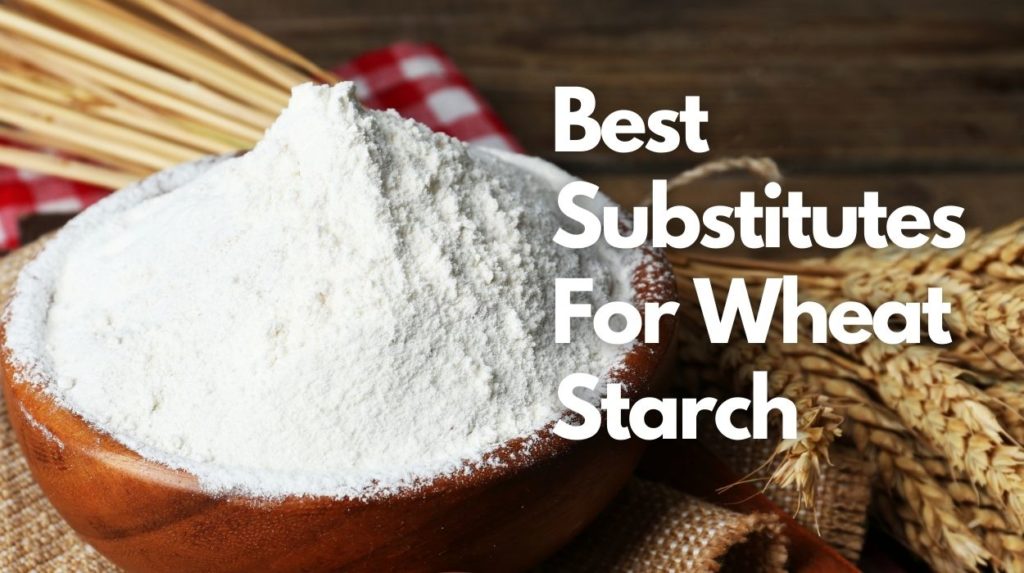
Wheat starch is one of the most commonly used ingredients in any household. But, few of us may also be allergic to wheat starch and grain starches in general. Some people have Celiac disease, a genetic disorder characterized by gluten sensitivity.
If you wonder, what are the possible wheat starch alternatives that you can use in your kitchen, you have landed at the right place! Regardless of your reason, you can use other substitutes like potato starch, corn starch, or ground flaxseed to recreate wheat starch’s same texture and gel formation capabilities.
But it is necessary to select the correct substitutes as per the recipes. If that confuses you, we highly suggest reading about it as we shall explain all the substitutes of wheat starch in detail.
Difference Between Wheat Starch and Wheat Flour

Many of us might get confused when it comes to an understanding the purpose of using wheat starch and wheat flour while preparing our delicacies. Since there is quite a vast difference, we will sum it up in short for you.
1. Wheat Flour
Every wheat grain contains 3 parts: the endosperm, the germ layer, and the wheat bran. The endosperm contains high levels of protein and starch that are majorly used to make wheat flour and wheat starch.
Wheat flour is again available in two types: Whole Grain and Refined Wheat Flour.
2. Whole Grain Wheat Flour
Whole grain wheat flour uses all three parts of the grain. Brown wheat flour uses the germ and the bran part and hence derives the name and color. These flours are nutrient-rich and high in fiber, fat, and protein content.
3. Refined Wheat Flour
Refined wheat flour is pure white as it is heavily processed. The flour is bleached, and the other parts, the bran, and germ are removed, leaving the fluffy white portion behind. Refined flour only uses the endosperm.
The endosperm is moistened to soften it before milling. After milling, the moisture evaporates, leaving a fine white powder behind. Wheat flour can be used as a binding agent to retain the protein.
Wheat flour has around 14% of protein after processing. The protein helps in giving a firm structure for preparing cakes, pancakes, bread, etc. Therefore, wheat flour is rich in gluten.
4. Wheat Starch
On the other hand, Wheat starch is made by processing and dissolving water-soluble starch, while the water is made to evaporate. Wheat starch is also purely made of the endosperm part of the grain. It is hydrated, and then the water is evaporated only to leave traces of starchy white powder.
Wheat starch should have no traces of the bran or germ, leaving you with 99% of starch and zero protein. Therefore, it is not sticky or gummy, and the particles are finer than wheat flour.
Wheat starch is majorly used as a thickening agent in gravies or batters. It helps develop thicker textures or binds certain ingredients together in any preparation. If it is not processed correctly, it may have certain amounts of protein in the form of gluten.
Best Wheat Starch Substitutes
1. Cornstarch
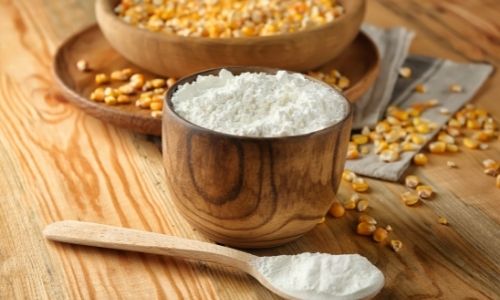
Cornstarch is considered to be one of the best alternatives to wheat starch. The reason being this is a pure form of starch with no gluten or other additives. Corn starch is made of corn kernels. The outer bran and germ from corn are removed, leaving only the starch-rich endosperm. Corn kernels have no gluten; therefore, it is a healthy alternative to wheat starch as well.
People who have Celiac disease (allergic to gluten) prefer corn starch to wheat starch. It serves as an excellent thickening agent and absorbs water well. You can use it for soups, gravies, stews, etc.
The quantity for using corn starch would be the same as wheat starch. In fact, doctors and dietitians also recommend corn starch to be an excellent substitute for wheat starch.
2. Xanthan Gum
Xanthan gum is a plant-based starch that uses sugar and a bacteria called Xanthomonas Campestris in its manufacturing process. It has a very slimy and sticky appearance and makes for a perfect thickening agent in various gravies, stews, cake batters, etc. The slimy solution is dried to convert into xanthan gum powder.
However, it is not a healthy alternative to wheat starch, as excessive use can cause digestive issues. It can also spoil the texture of your dish if used in excess. Plus, xanthan gum is too chewy and may almost hurt your jaws due to the slimy, rubber, gum-like texture while eating.
For using it as a substitute, only a quarter spoon of xanthan gum works best for adequate consistency and texture in your preparations.
3. Guar Gum
Guar gum is another plant-based derivative obtained from guar beans. The husk from guar beans is removed, which leaves the starch-rich endosperm. The endosperm is dried and then ground into starch powder.
Guar gum does not cause digestive issues, unlike xanthan gum. Guar gum is considered a much healthier alternative to xanthan gum. Additionally, guar gum is also rich in fiber and has low calories. Plus, it is a cheaper and healthier alternative to wheat starch and xanthan gum.
Guar gum forms a very thick solution if used in curries or gravies, and hence only a minute quantity would suffice as a substitute. You can use a quarter spoon of guar gum to substitute for wheat starch.
4. Ground Flaxseeds

Ground Flaxseeds do not have a starch-like consistency but are more coarse and gritty. Flax Seeds, however, are considered to be a superfood and have several nutritional benefits. Flaxseeds are rich in soluble fiber and as well as antioxidants.
They also help in preventing constipation, help in controlling cholesterol and blood pressure, and are highly recommended for patients with heart disease or diabetes.
Flax seeds can form a jelly-like consistency when ground and mixed with water and thicken your food preparations. Therefore, you would need only half the quantity of flax seeds as wheat starch.
Use: Use one tablespoon of ground flaxseeds with 4 tablespoons of water to substitute for 2 tablespoons of wheat starch.
Pro Tip: Since flax seeds are rich in soluble fiber, you can use them as toppings while making dough, bread, soups, stews, gravies, etc. It adds to the nutritional content of your food.
5. Psyllium Husk

If you are looking for a complete gluten-free alternative to starch, Psyllium Husk is a great substitute. It is extremely rich in fiber and has zero carbohydrates and fat. It is also dense in calories and serves as an excellent thickening agent.
Since it forms a very thick consistency when mixed with solutions, you need to be careful about the measurements when using Psyllium Husk as a substitute.
Use just a teaspoon for starters, and keep adding until you achieve the desired consistency.
It is a healthy wheat starch alternative and suitable for those allergic to gluten.
6. Potato Starch
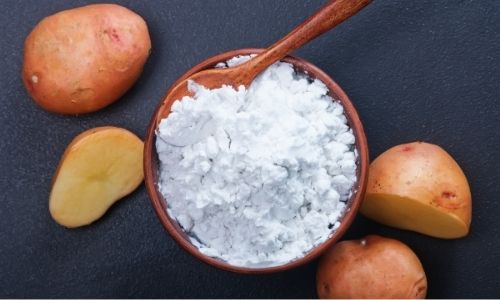
Potato Starch is another excellent alternative to wheat starch. It is extracted from freshly crushed potatoes. The extract is then dried and ground into powder form.
This is a vegetable-based starch, so it does not contain gluten. However, it is dense in carbs, fats, and protein. In short, it is dense in calories. It is safe for people with gluten and grain allergies.
Potato starch is an excellent ingredient to add taste to your food. It makes food items crispy and chewy. At the same time, the carbohydrate bonds in potato starch are heat sensitive, which causes the breakdown of carbohydrate molecules.
If you use potato starch as a substitute for wheat starch, use it in a 1:1 ratio. You would need the same amount of potato starch as wheat starch. But, potato starch is highly dense and thickens quickly. Therefore, you need to watch the amounts before adding.
7. Tapioca Starch
Tapioca starch is extracted from a well-known root worldwide, i.e., Cassava. The Cassava roots are ground and filtered to get a liquid-like consistency. This liquid can then be dried to obtain tapioca starch powder.
Cassava contains a harmful chemical called cyanide which is dangerous to health. Therefore, Cassava needs to be boiled thoroughly for at least 20 minutes to remove the chemical.
Tapioca does not thicken quickly, unlike other starches. Therefore, you can use more quantities of tapioca starch without worrying that your food item will get thick.
When using as a substitute, use 2 tablespoons of tapioca starch/flour instead of 1 tablespoon of wheat starch.
8. Arrowroot Powder
Another healthy alternative to wheat starch and other forms of starches is Arrowroot powder. It is extracted from plants belonging to the Maranta genus, commonly found in tropical regions. The roots are dried and ground to form a fine powder.
Since the starch belongs to a plant source, it is gluten-free. It serves as an excellent thickening agent in cooking, especially as a substitute for cornstarch. It is rich in fiber and nutrition, which gives you several reasons to use arrowroot starch as an alternative.
If using it as a substitute for wheat starch, use 4 tablespoons of arrowroot powder instead of 2 tablespoons of wheat starch.
9. Rice Starch
Rice starch is a natural polymeric carbohydrate. Rice starch is often assumed to be gluten. However, it is gluten-free, making it a favorable substitute for people with gluten intolerance.
This can be used to thicken sauces.
As opposed to every tablespoon of wheat starch, you can add 1/2 tablespoon of rice starch.
10. Glucomannan
Glucomannan is a water-soluble dietary fiber that comes from elephant yam roots. While this is generally used as a dietary supplement for losing weight, it can be used as a wheat substitute, especially to thicken pasta, soups, and noodles.
One tablespoon of wheat starch can be substituted with half a spoon of Glucomannan. Not only does it help thicken the sauce, but it also reduces hunger and stabilizes blood sugar levels.
11. Mung Bean Starch
While this substitute is not recommended for people with digestive issues, Mung bean starch can be used as a wheat starch alternative in sweet and savory Asian cuisines. It is made by extracting the starch from the beans. Since it is white, it can be easily added to all kinds of recipes.
You can use the same proportion as wheat starch while substituting it.
12. Water Chestnut Starch
Water chestnut starch, or water chestnut flour, is made from ground water chestnuts. These nuts are boiled and ground into flour or starch. It is white in color and can be used to thicken batters, especially in Asian and Indian cuisines.
While substituting wheat starch with walnut chestnut starch, one can use the same proportion.
What are the Uses of Wheat Starch?
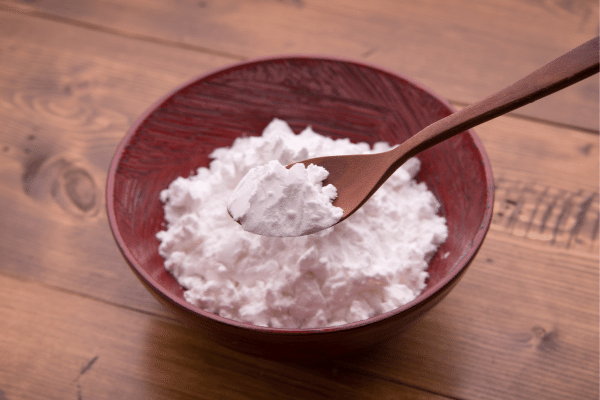
Wheat starch has a wide range of uses apart from just cooking. It can be used as an adhesive or even in cosmetics. You can easily find wheat starch in any local grocery store or health food store around you.
Some of the most common uses of wheat starch are:
1. Cooking
Wheat starch is a common thickening agent used while making sauces, gravies, or soups. It can be used as a substitute for cornstarch to thicken batters for pancakes or pie fillings. However, it does not thicken as much as corn starch because of the finer particle size.
Certain types of doughs also use wheat starch, e.g., while preparing dumplings. It makes them look translucent and appealing as well. The best way to use wheat starch while cooking is to mix it with water; else, it may end up forming lumps.
2. Glue
Starch glue is used in binding books, for sticking wallpapers, and many such applications. Wheat starch is a widely known common ingredient used in making glue. You can also use rice starch instead, but starch glue has incredible adhesive power.
Basically, glue is prepared by heating wheat starch with water on high heat until it forms a paste. The paste is then filtered and strained to get the glue separated. You can also store the prepared paste and make glue after a week from the paste.
If the paste becomes stiff, soften it using warm water. You can store the glue in the refrigerator, but if it has a foul odor, it means it has gone bad.
How to Choose the Best Wheat Starch Substitute?
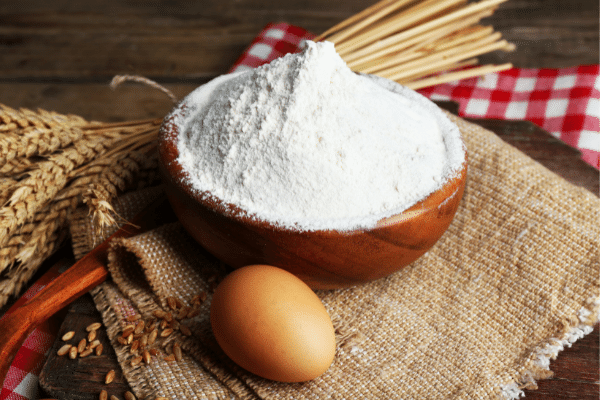
Starch is mainly composed of two components – amylose and amylopectin. These components determine the properties of various dishes that you can prepare using starch.
Based on how you want the final result of your dish to be, you can choose starch substitutes having higher or lower quantities of these components. The best would be to go for a starch substitute having high amounts of amylopectin and low amounts of amylose.
Let us look at the properties of these two components:
1. Low Amylose
Starch with low amylose can be cooked for longer without losing its viscosity.
This type can be easily used to improve the texture of any dish, and the thickness is such that it can be sliced with a knife.
Once frozen, it becomes spongy and can leak fluids if broken. The solution using this type of starch can remain transparent when hot but turns opaque when cold.
Common examples of this starch type are wheat and corn. If you are baking cakes or pies, then this starch type is an ideal choice.
2. High Amylopectin
Starch with high amylopectin remains thick at lower temperatures but does not retain thickness at higher temperatures.
This is best for gravies or soup, or sauces that do not require a very firm and thick consistency.
This starch can be easily frozen.
The solution using this type of starch remains clear, whether hot or cold.
The final dish appears to have a glossy coating.
The best examples of this starch type are arrowroot and tapioca starch. They more or less have a waxy gel-like consistency when you mix them with liquids.
Can I make my own Wheat Starch?
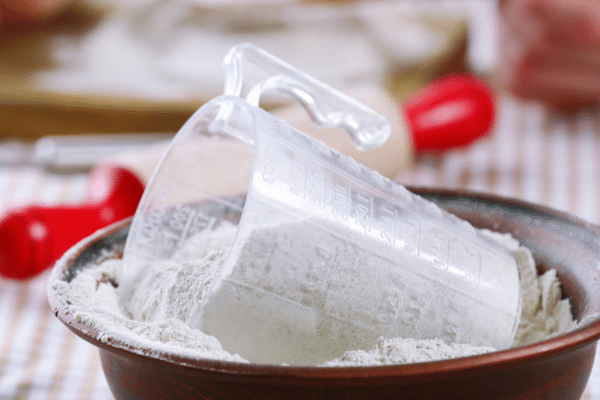
If you do not rely on wheat starch available in a local store around you, you can prepare your own wheat starch at home. There are two methods to do that. Let us brief you on both of them.
Method 1:
- Take some quantity of wheat flour and wash off the gluten content in the flour with water.
- Collect the washed water and keep it still for a while.
- All the starch content in the water will precipitate and settle at the bottom.
- Collect this starch in a filter or muslin cloth and dispose of the gluten water.
You can use this starch for frying, steaming, baking, and many other related recipes. The starch is usually white in color and smooth in texture. You can use it to make noodles, bake bread, prepare pancakes, pies, etc.
Method 2:
Follow this method if you want a tougher wheat starch made at home.
- Take some appropriate quantity of wheat flour and knead it into a dough with water.
- After the dough is made, make sure that it is not sticky, and that the consistency is smooth. Cover the dough lump with a damp cloth for 1-2 hours.
- The dough will swell up within 2 hours. Now, take the lump to a basin and add 3-4 times the water to the dough.
- Repeat the dough properly with both hands. The starch in the dough is washed into the latter.
- Make sure to collect the water used for washing as it contains all the washed starch from the dough.
- Repeat the washing procedure at least 3-4 times, and knead the dough until it becomes thick after adding water.
- Lastly, the dough would become very stretchy, and there would be no pulp coming out of the dough. This means all the starch is washed out, and the gluten, the stretchy part remains in the dough.
- Now, pour the collected washing starch water together through an 80 mesh sieve, and allow the water to settle for 12 – 24 hours.
- Transfer all the precipitated starch into a cotton cloth or clean cotton bag, and hang it in a sunny, well-ventilated place.
- Allow it to dry in smaller batches or the whole stock at once. Your homemade wheat starch is ready!!
Substitute for wheat starch in Har Gow
Wheat starch is used as a binder while preparing Har Gow as it helps in retaining the shape of the dumplings. In case you run out of it, you can use substitutes like potato starch or xanthan gum to prepare the best Har Gow.
Wheat starch substitute for Bao
Potato starch is the best substitute for wheat starch while preparing bao. It helps in binding the dumpling and holds its shape for a long period.
FAQs
Does wheat starch contain gluten?
Yes, and No! Purely processed and refined wheat starch does not contain gluten. However, if the processing is not done accurately, you may find small traces of gluten protein in wheat starch.
You can remove the gluten by dissolving wheat starch in water and settling the gluten solids at the bottom.
Can you modify wheat starch?
Yes! Wheat starch can be modified. Wheat starch has emulsifying properties, which change the quality of your food products in terms of texture. Most starch types are modified before use in food items.
Is wheat starch the same as bread flour?
No! Wheat starch and flour are different. Bread is made of refined wheat flour, which contains gluten, unlike wheat starch. However, you can use wheat starch purely to make bread or use cornstarch as a better and tastier alternative to wheat starch.
Is cornstarch the same as wheat starch?
No! Corn starch and wheat starch are made of different grain sources. However, they can contain gluten and are efficient thickening agents. They are medium-sized ground grain granules that gelatinize at high temperatures.
Therefore, they are used to improve the consistency of food items like soups, gravies, etc.
Is Wheat Starch Safe For Eating?
As far as the wheat starch is labeled gluten-free, it will not cause any harm to your health. You can use it in your recipes for binding, texture, moisture retention, gel formation, etc.
Is wheat starch and Maida the same?
Wheat starch is obtained from the processed endosperm of the wheat grain. On the other hand, maida is a white flour made from wheat.
How Long Can You Keep Wheat Starch?
Wheat starch can be stored for 6 months at room temperature, given the fact that proper storage facilities are maintained.
What is wheat starch in Chinese cooking?
Wheat starch can be added to thicken sauces or mix it with rice. Generally, it is added while preparing dim sum and steamed rice rolls.
Conclusion
Wheat is a rich source of fiber, protein, carbohydrates, etc. One of wheat grain’s most widely used components is wheat starch. After tedious levels of processing and refining, wheat starch is separated from wheat gluten.
However, some are sensitive to wheat gluten that remains in the wheat starch due to poor processing techniques. Therefore, we have come up with some healthy, gluten-free alternatives to wheat starch and show you how to use them.
Please read our article above and tell us which is your best substitute for wheat starch in the comments section below.
Until then, happy cooking!



